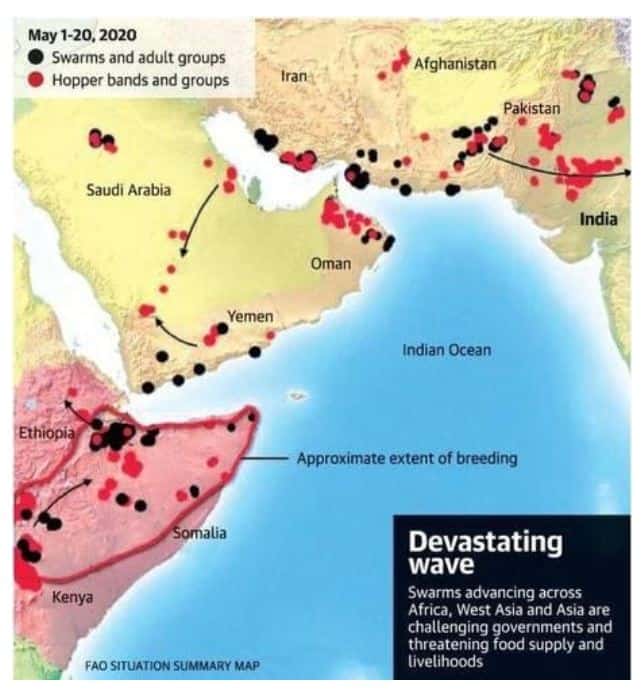UPSC Articles
GEOGRAPHY/ ENVIRONMENT/ GOVERNANCE
Topic: General Studies 2,3:
- Structure, organization and functioning of the Judiciary
- Government policies and interventions for development in various sectors
Locust surge posing a threat to agriculture in India
Context: The outbreaks of the locust attack have been reported from Gujarat, Rajasthan, Maharashtra, Madhya Pradesh, Punjab, Haryana and Uttar Pradesh.
What are locusts?
- The desert locust (Schistocerca gregaria) is a short-horned grasshopper.
- They differ from ordinary grasshoppers in their ability to change behaviour (gregarize) and form swarms that can migrate over large distances.
- They can rapidly reproduce and increase some 20-fold in three months.
- The normal locust season in India spans June-November and coincides with the kharif season.

Pic Source: The Hindu
When was the last big outbreak?
- There were serious outbreaks in 1812, 1821, 1843-44, 1863-67, 1869-73, 1876-81, 1889-98, 1900-1907, 1912-1920
- A particularly bad season in 1926-1931 prompted the British to set up Locust Warning Organization (LWO) in Karachi (undivided India)
- The last major upsurge in India occurred in 1993
- In 2019, Gujarat and Rajasthan reported a significant surge in locust infestations whereby nearly 3.5 lakh hectares of cumin, rapeseed and mustard were damaged
- This was partly due to an unusually long monsoon but also because pest-control operations were inadequate
What is the climate link to the infestation?
- A pattern of warming in the Indian Ocean may be a trigger.
- A phenomenon called the Indian Ocean Dipole, in which the western and eastern parts of the ocean, warm differentially, tend to have an outsized impact in bringing excessive rains to India and West Asia
- A ‘positive’ dipole is when the western part is hotter by a degree or more than the eastern.
- 2019 saw one of the strongest positive dipoles (difference of more than 2 degrees) in the Indian neighbourhood, that it over-rode concerns of a drought in India and brought torrential rainfall
- As a result, monsoons also lasted nearly a month more than what is normal.
- This extended rainfall continued in several parts of West Asia, Oman, Yemen and in the Horn of Africa — Ethiopia, Somalia, Kenya — so much so that that the dry sand became heavily moisture laden, facilitating the formation of several locust swarms.
- Due to favourable winds, it helped swarms to fly and breed in traditional grounds in Iran, Afghanistan, Pakistan and India.
- The unusually mild summer in 2020, which saw several bouts of rainfall over north and western India from March to May, also helped the insects breed.
How are locust invasions dealt with?
- A locust attack has to be dealt with by spraying pest control and plant protection chemicals.
What is the concern this time?
- National Emergencies: Somalia announced a national state of emergency due to the outbreak in February 2020, while Pakistan declared a national emergency for the second time this year, in April.
- Early Arrival: In India, so far swarms have been recorded in nearly 50,000 hectares in Rajasthan and Madhya Pradesh. If they continue to thrive as the monsoon arrives, it could cause serious agricultural damage.
- Can impact Central & Eastern India: Existing groups of swarms have continued to move east and towards central India. Much of these movements were associated with the strong westerly winds of Cyclone Amphan.
- Can Last Longer than usual: Several successive waves of invasions are likely until July in Rajasthan, with eastward surges across northern India as far as Bihar and Odisha
- Corona Pandemic: The national lockdown in the wake of COVID-19 has made the availability of pesticide as well as its transportation difficult. This means inadequate pest control capabilities of authorities
- Shortage of labour: With labour also not being available easily due to the lockdown, spraying operations have been effected and, as a result, locusts are increasing
- Increased regularity: Experience shows that a locust plague usually follows a one to two year cycle after which there is a lull for eight to nine years. However, strong Indian Ocean Dipoles are expected to become more frequent due to global warming of oceans which means regular locust attacks
Is adequate action being taken?
- It has been part of the protocol for many years, for entomologists from India and Pakistan to conduct border meetings and divide pest control responsibilities
- Indian officials, last year and this year too, have blamed Pakistan for not spraying adequate pesticide to stem the nascent population
- Experts have warned of huge crop losses if the swarms are not stopped by June when the monsoons will lead to a new season of sowing rice, sugarcane, cotton and other crops.
Conclusion
- Going forward, there has to be increased focus on natural disasters such as cyclones as well as locust attacks.
Connecting the dots:
- UN Food and Agricultural Organisation
- National Disaster Management Act, 2005














